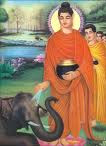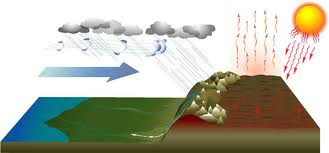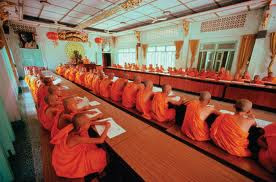183 LESSON 01 03 2011 Samiddhi Sutta About Samiddhi FREE ONLINE eNālandā Research and Practice UNIVERSITY to VOTE for BSP ELEPHANT for Social Transformation and Economic Emancipation to attain Ultimate Bliss-Buddhist perception of Languages and Literature-VOICE OF SARVAJAN HONEYLEAKS-Once again UPA Denies SCs Rs.Cr. 24,570 in Scheduled caste Plan and STs Rs.Cr. 10530 in Tribal Sub Plan
through
Course Programs:
LESSON 183
http://www.accesstoinsight.org/tipitaka/sn/sn01/sn01.020.than.html
SN 1.20
PTS: S i 8
CDB i 97
Samiddhi Sutta: About Samiddhi
translated from the Pali by
Thanissaro Bhikkhu
Alternate translation: Walshe
Translator’s note: The Pali canon is unique in its approach to the spirit world. While confirming the existence of spirits and other more refined levels of beings, it insists that they are not worthy of worship. The Buddha, after all, is the teacher not only of human beings but also of heavenly beings; and many heavenly beings are not especially knowledgeable or spiritually advanced, in spite of their refined state. The Canon illustrates this point in a number of gentle satires. The most famous is the Kevatta Sutta (DN 14), where the ignorance & pomposity of a supposedly all-knowing creator is lampooned. This discourse is another entertaining example of the same genre, pointing out the difficulties of teaching more advanced Dhamma to any being — human or divine — who is obsessed with sensual pleasures. On hearing some verses concerning the awakened one’s state of mind — which is not subject to time and is visible here-&-now — the devata cannot understand them, and is able to grasp only a few very basic principles of Dhamma practice. It’s unusual for the Buddha to aim his words so far over the heads of his listeners. Perhaps in this case, as in SN 1.1, he wants to subdue the devata’s pride. At any rate, there is hope for her: as the Commentary points out, her understanding covers in a rudimentary fashion all the elements of the Noble Eightfold Path. If she follows through with her understanding, she’s on the road to the higher attainments.
This discourse also contains some word play on the words “time” (kala) and “subject to time” (kalika). “Time” can mean not only time in the general sense, but also one’s time of death (a person who has died is said to have “done his/her time”). These two meanings of the word underlie the first exchange between Ven. Samiddhi and the devata. “Subject to time” can mean “obtainable only after a certain time” or “good only for a certain length of time”: these meanings underlie their second exchange.
I have heard that on one occasion the Blessed One was staying near Rajagaha at Tapodamonastery. Then Ven. Samiddhi, as night was ending, got up & went to the Tapoda Hot Springs to bathe his limbs. Having bathed his limbs and gotten out of the springs, he stood wearing only his lower robe, letting his limbs dry.
Then a certain devata, in the far extreme of the night, her extreme radiance lighting up the entire Tapoda Hot Springs, approached Ven. Samiddhi. On arrival, while standing in the air, she addressed him with this verse:
Without having enjoyed
[sensual pleasures],
you go for alms, monk.
You don’t go for alms
after having enjoyed.
Having enjoyed, monk,
then go for alms.
Don’t let time pass you by.
[Ven. Samiddhi replied:]
I don’t know my time.
My time
is hidden.
It can’t be seen.
That’s why, not having enjoyed,
I go for alms:
Don’t let my time pass me by.
Then the devata, coming down to earth, said to Ven. Samiddhi, “You have gone forth while young, monk — black-haired, endowed with the blessings of youth in the first stage of life — without having played with sensual pleasures. Enjoy human sensuality, monk. Don’t drop what is visible here-&-now in pursuit of what’s subject to time.”
“My friend, I’m not dropping what’s visible here-&-now in pursuit of what’s subject to time. I’m dropping what’s subject to time in pursuit of what’s visible here-&-now. For the Blessed One has said that sensual pleasures are subject to time, of much stress, much despair, & greater drawbacks; whereas this Dhamma is visible here-&-now, not subject to time, inviting all to come & see, pertinent, to be known by the wise for themselves.”
“But, monk, in what way has the Blessed One said that sensual pleasures are subject to time, of much stress, much despair, & greater drawbacks? And how is this Dhamma visible here-&-now, not subject to time, inviting all to come & see, pertinent, to be known by the wise for themselves?”
“I’m new, my friend, not long gone forth, only recently come to this Dhamma & discipline. I can’t explain it in detail. But the Blessed One, worthy & rightly self-awakened, is staying here in Rajagaha at Tapoda monastery. Having gone to him, ask him this matter. As he explains it, that’s how you should remember it.”
“Monk, it’s not easy for us to go to the Blessed One, as he is surrounded by other devas of great influence. But if you go to the Blessed One and ask him this matter, I will come along to hear the Dhamma.”
Responding to the devata, “As you say, my friend,” Ven. Samiddhi went to the Blessed One. On arrival, he bowed down to the Blessed One and sat to one side. As he was sitting there [he told the Blessed One his entire conversation with the devata]. “Now, lord, if that devata was telling the truth, she is not far from here.”
When this was said, the devata said to Ven. Samiddhi, “Ask, monk! Ask! I’ve gotten through.”
Then the Blessed One recited this verse to the devata:
Perceiving in terms of signs, beings
take a stand on signs.
Not fully comprehending signs, they
come into the bonds
of death.
But fully comprehending signs, one
doesn’t construe
a signifier.
Yet nothing exists for him
by which one would say,
‘To him no thought occurs.’
If you know this, spirit, then say so.
“I don’t understand, lord, the detailed meaning of the Blessed One’s brief statement. It would be good if the Blessed One would speak in such a way that I would understand the detailed meaning of the Blessed One’s brief statement.”
[The Blessed One said:]
Whoever construes
‘equal,’
’superior,’ or
‘inferior,’
by that he’d dispute.
Whereas to one unaffected by these three,
‘equal’
’superior’
do not occur.
If you know this, spirit, then say so.
“I don’t understand, lord, the detailed meaning of the Blessed One’s brief statement. It would be good if the Blessed One would speak in such a way that I would understand the detailed meaning of the Blessed One’s brief statement.”
[The Blessed One said:]
Having shed classifications,
gone beyond conceit,
he has here
cut
through craving
for name
& form:
This one —
his bonds cut through,
free from trouble,
from longing —
though they search they can’t find him,
human & heavenly beings,
here & beyond,
in heaven
or any abode.
If you know this, spirit, then say so.
“Lord, here’s how I understand the detailed meaning of the Blessed One’s brief statement:
In all the world,
every world,
you should do no evil
with speech,
body,
or mind.
Having abandoned sensual pleasures
— mindful, alert —
don’t consort with suffering & stress,
with what doesn’t pertain
to the goal.”
Sn 4.9









Buddhist perception of Languages and Literature
http://www.scribd.com/doc/30887951/Kanai-Lal-Hazra-Pali-Language-and-Literature-Vol-I

Sinhala, Buddhist Literature in
SINHALA, BUDDHIST LITERATURE IN
Sinhala is the language of 72 percent of the population of Sri Lanka. Sinhala is considered part of the Indo-European family of languages, but recent scholarship has revealed a strong Dravidian influence as well. No written documents exist of the period before the coming of Buddhism in the third century b.c.e.; with Buddhism, a written literature developed. The earliest extant records are cave and rock inscriptions in a Brāhmī script dating from around 200 b.c.e., which list the names of Buddhist donors who supported cave dwelling monks. This connection between the language and the religion, established very early, gave rise over time to a vigorous Buddhist literature.
As far back as the first century b.c.e., Buddhist monks at Aluvihāre in central Sri Lanka committed Buddhist texts to writing. Monasteries quickly developed into centers of literary and intellectual activity, and a substantial collection of religious works, commentaries, exegetical writings, and historical records appeared in Pāli, Sanskrit, and the local vernacular. Most of the early works have not survived, but scholars know of their existence from references in later texts and from rock inscriptions. The only extant works from before the eighth century c.e. are the historical chronicles the Dīpavaṃsa (fourth century c.e.), the Mahāvaṃsa (sixth century c.e.), and its continuation theCulavamsa (twelfth century c.e.), which were all …
Read the rest of this article, courtesy of your local library
Related newspaper, magazine, and trade journal articles from HighBeam Research
(Including press releases, facts, information, and biographies)
 The Sinhala-Buddhist civilisation.
The Sinhala-Buddhist civilisation. …22 — Sri Lanka’s Sinhala -Buddhist civilization is the…this day. The word ‘Sinhala‘ describes the island…derive from the word ‘Sinhala‘. The island was called…Sinhaladipa in the Vedic literature. Allahabad inscription…
 On Liyanage Amarakeerthi’s anti-Sinhala Buddhist rant
On Liyanage Amarakeerthi’s anti-Sinhala Buddhist rant …is “Sinhala Buddhist nationalism…theories about literature but ideological…problem with Sinhala Buddhists and “nationalists…most seniorSinhala writers are nationalists…dominance of the Sinhala Buddhist nationalist discourse…
 Patriotic Sinhala poet
Patriotic Sinhala poet …tiny state Sikkhim, a Buddhist country. In 1901…was also a centre of Buddhist learning under the guidance…The great block of Buddhist literaturethough not - ‘Theravada…gain a knowledge of Sinhala, Pali and Sanskrit…
 Patriotic Sinhala poet.
Patriotic Sinhala poet. …tiny state Sikkhim, a Buddhistcountry. In 1901…was also a centre of Buddhist learning under the guidance…The great block ofBuddhist literature though not - ‘Theravada…gain a knowledge of Sinhala, Pali and Sanskrit…
 W. A. Silva and Sinhala novel
W. A. Silva and Sinhala novel …its kind in Sinhala Literature. During the last years…the translation into Sinhala of Valmiki’s “Ramayana…significant contribution toSinhala novel by reaching wider…setting the foreground of Sinhala fiction and whose work…police officers, Buddhist monks, prostitutes…
 Indelible Professor in Sinhala and Sociology.
Indelible Professor in Sinhala and Sociology. …service in the fields of Sinhalaliterature, Sociology, Folklore…talents. He became the Buddhist Brotherhood Association…students, as the Leader of Sinhala Bhasha Peramuna. Therefore…recognized, as the hero of Sinhala Bhasha. In the first…
 Indelible Professor in Sinhala and Sociology
Indelible Professor in Sinhala and Sociology …service in the fields of Sinhala literature, Sociology, Folklore…talents. He became the Buddhist Brotherhood Association…students, as the Leader ofSinhala Bhasha Peramuna. Therefore…recognized, as the hero of Sinhala Bhasha. In the first…
 The Sinhala state from Dambadeniya to Kotte
The Sinhala state from Dambadeniya to Kotte …concerned about preservation of Buddhist texts. He reformed the sangha…Kavsilumina and Visuddimagga sannaya. Sinhala literature flourished. Pujavaliya, Sidat…invaded a port in Tanjore because Sinhala traders had been humiliated. Buvaneka…

Novel changed course of Sinhala fiction
…Sinhala language and literature is hallowed ground…those who consider the Sinhala language and culture…fashioned his vision ofSinhala culture, religion and…Koggala. At a time when Sinhala writers believed that…was attracted by the Buddhist perception of change.

VOICE OF SARVAJAN HONEYLEAKS
[The Buddhist Circle] Fw: [sakya] PMARC : Once again UPA Denies SCs Rs.Cr. 24,570 in Scheduled caste Plan and STs Rs.Cr. 10530 in Tribal Sub Plan
FYI
Bhanteji
— On Mon, 28/2/11, ARUN KHOTE
Bhanteji
From: ARUN KHOTE
Subject: [sakya] PMARC : Once again UPA Denies SCs Rs.Cr. 24,570 in Scheduled caste Plan and STs Rs.Cr. 10530 in Tribal Sub Plan
To: “sakyagroup”
Date: Monday, 28 February, 2011, 4:39 PM
National Campaign on Dalit Human Rights
Dalit Arthik Adhikar Andolan
Press Release
Budget 2011-12
Once again UPA Denies SCs Rs.Cr. 24,570 in Scheduled caste Plan and STs Rs.Cr. 10530 in Tribal Sub Plan
Together for SCs & STs, allocates only 4.03% for in both Plan and Non-plan budgets
The Demands for Separate budget head for SCs and STs realized
In the budget that has been presented today, the expenditure for both SCs and STs in Plan and Non-plan budgets is a mere 4.03% of the total budget. For a population of 24.4% of the total country this is a mere lip-service and shows no real policy concern for the development of the vulnerable sections of the society.
Once again the allocations for Scheduled Castes Sub Plan and Tribal Sub Plan in the Union budget have a huge gap. The union budget as allocated Rs.Cr. 30551 to the SC development and Rs.Cr. 17,371 to ST development. It is 8.98% of the total plan out lay for SCs and 5.11% to STs. There is a gap of Rs. Cr.24,570 in SCP and RS.Cr. 10,530 for TSP. There is an increase of Rs.Cr.9,927 for SCs and Rs.Cr.5,625 for STs from last years allocation.
The Finance Minister in the Budget speech confirmed that this year the much demanded budget code for SCP 789 and TSP 796 has been opened which enables not only for clear allocations but makes them trackable.
|
|
Amount in Rs. Cr. |
|
|
Particulars |
10-11 (BE) |
11-12 (BE) |
|
Total Budget |
1108749 |
12577282 |
|
Total Plan Expenditure |
373092 |
441547 |
|
Transfer to State and UT |
88808 |
101292 |
|
Available Plan outlay with Central Min/Dept |
284284 |
340255 |
|
DUE SCP (16.2%) |
46054 |
55121 |
|
SCP Allocation |
20624 |
30551 |
|
% Allocated as per Plan Outlay |
7.25% |
8.98% |
|
Denied to SCs |
25430 |
24570 |
|
DUE Tribal Sub Plan (8.2%) |
23311 |
27900 |
|
TSP Allocation |
11746 |
17371 |
|
% Allocated as per Plan Outlay |
4.13 |
5.11 |
|
Denied to STs |
11,565 |
10530 |
It is unfortunate that only 24 departments have allocated for SCs and for STs 26 departments. While all the departments must allocate the funds for development mainly the growth sector departments claim they are unable to allocate the money.
The economic growth departments that have not allocated are Departments of Coal, Road transport and highways, Railways, Power, Space, Civil Aviation, Home, Petroleum and Chemicals etc. This shows that most of these finances are allocated for social services and very little for economic services which means that real development does not take place in the case of SCs and STs. They are not present in the growth sectors of the economy and are mere service providers for the rest of the society. This maintains the age old caste system which makes SCs and STs only to be subservient to the rest of the society. Is Union Government maintaining this through their budget allocations?
Though the Statement 21 and 21 A shows allocations made to SCP and TSP, in the past years thease allocations do not correspond to the Detailed Demand for Grants indicating that these funds are not allocated in terms of actuals within the Department Budgets.
It is therefore not surprising that the Human Development Index for India is 119 out of 169 countries below the countries like Sri Lanka.
ARUN KHOTE
Monday, 28 February 2011 7:42 PM
http://www.orgsites.com/oh/awakenedone/
Awakeness Practices
All 84,000 Khandas As Found in the Pali Suttas
|
Traditionally the are 84,000 Dharma Doors - 84,000 ways to get Awakeness. Maybe so; certainly the Buddha taught a large number of practices that lead to Awakeness. This web page attempts to catalogue those found in the Pali Suttas (DN, MN, SN, AN, Ud & Sn 1). There are 3 sections: |
The discourses of Buddha are divided into 84,000, as to separate addresses. The division includes all that was spoken by Buddha.”I received from Buddha,” said Ananda, “82,000 Khandas, and from the priests 2000; these are 84,000 Khandas maintained by me.” They are divided into 275,250, as to the stanzas of the original text, and into 361,550, as to the stanzas of the commentary. All the discourses including both those of Buddha and those of the commentator, are divided into 2,547 banawaras, containing 737,000 stanzas, and 29,368,000 separate letters.
BUDDHA (EDUCATE)! DHAMMA (MEDITATE)! SANGHA (ORGANISE)!
WISDOM IS POWER
Awakened One Shows the Path to Attain Eternal Bliss
Using such an instrument
The Free ONLINE e-Nālandā Research and Practice University has been re-organized to function through the following Schools of Learning :
Buddha’s Sangha Practiced His Dhamma Free of cost, hence the Free- e-Nālandā Research and Practice University follows suit
As the Original Nālandā University did not offer any Degree, so also the Free e-Nālandā Research and Practice University.
The teachings of Buddha are eternal, but even then Buddha did not proclaim them to be infallible. The religion of Buddha has the capacity to change according to times, a quality which no other religion can claim to have…Now what is the basis of Buddhism? If you study carefully, you will see that Buddhism is based on reason. There is an element of flexibility inherent in it, which is not found in any other religion.
Bhimrao Ramji Ambedkar , Indian scholar, philosopher and architect of Constitution of India, in his writing and speeches
IKAMMA,REBIRTH,AWAKEN-NESS,BUDDHA,THUS COME ONE,DHAMMA II.ARHA ,FOUR HOLY TRUTHS,EIGHTFOLD PATH,TWELVEFOLD CONDITIONED ARISING,BODHISATTVA,PARAMITA,SIX PARAMITAS III.SIX SPIRITUAL POWERS,SIX PATHS OF REBIRTH,TEN DHARMA REALMS,FIVE SKANDHAS,EIGHTEEN REALMS,FIVE MORAL PRECEPTS IV. MEDITATION,MINDFULNESS,FOUR APPLICATIONS OF MINDFULNESS,LOTUS POSTURE,SAMADHI,CHAN SCHOOL,FOUR JHANAS,FOUR FORMLESS REALMS V. FIVE TYPES OF BUDDHIST STUDY AND PRACTICE,MAHAYANA AND HINAYANA COMPARED,PURE LAND,BUDDHA RECITATION,EIGHT CONSCIOUSNESSES,ONE HUNDRED DHARMAS,EMPTINESS VI. DEMON,LINEAGE
with
Level I: Introduction to Buddhism,Level II: Buddhist Studies,
TO ATTAIN
Level III: Stream-Enterer,Level IV: Once – Returner,Level V: Non-Returner,Level VI: Arhat
Jambudvipa, i.e, PraBuddha Bharath scientific thought in
mathematics,astronomy,alchemy,andanatomy
Philosophy and Comparative Religions;Historical Studies;International Relations and Peace Studies;Business Management in relation to Public Policy and Development Studies;Languages and Literature;and Ecology and Environmental Studies
Jambudvipa, i.e, PraBuddha Bharath scientific thought in
Mathematics
Astronomy
Alchemy
And Andanatomy
Buddhist perception of humanity
Buddhism and Information Technology
Buddhist perception of Business Management in Relation to Public Policy and Development and Ecology and Environment